This is the final program for 2009. TechByter Worldwide will be back on January 3, 2010, with a slightly new look. I hope that the remainder of this year meets or exceeds your desires and that the coming year is enjoyable, entertaining, and educational.
Fixing Exposure Problems with Creative Layers and Masking
Sometimes the images you see on your screen when you download them to your computer don't look like what you saw in real life. It's not your photographic ability. It's not your camera. It's physics that gets in the way and, to some extent, perception. When we look at a scene in real time, our eyes move and adjust so that we perceive detail in both dark areas and light areas. Cameras aren't like that. They make one exposure that sees everything at once. Adobe's Michael Ninnes helped me understand how to fix this kind of problem with Photoshop and I'd like to share the technique with you.
Click any of the smaller images for a full-size view.
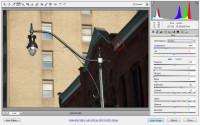 Here's a picture that I took in downtown Columbus. I'm using the eyedropper tool to sample an area that should be a neutral color. You'll see that the windows in the background building are too bright and the brick building in the foreground is too dark. This isn't what I saw and I wanted to fix it. But I needed some help.
Here's a picture that I took in downtown Columbus. I'm using the eyedropper tool to sample an area that should be a neutral color. You'll see that the windows in the background building are too bright and the brick building in the foreground is too dark. This isn't what I saw and I wanted to fix it. But I needed some help.
Earlier this year, I interviewed Michael Ninnes of Adobe and we talked about the CS4 version of InDesign. Ninnes is clearly a smart guy. While he was in college at the University of Washington, he was already teaching professional designers and photographers how to use the new tools. Then he moved a few blocks to Adobe's Seattle campus.
In December, I spent about 3 hours with Michael showing me, one-on-one, some of the neater effects that can be accomplished with masking and blend modes. I have a decent understanding of masking, but blend modes had largely eluded me. After 3 hours, I had a clear understanding of the basics.
TRUTH IN REPORTING: I did not sit down in the same room with Michael Ninnes and he didn't really spend 3 hours with me even though I spent 3 hours with him. I used Lynda.com to watch a program on the subject, Michael Ninnes: Photoshop CS4 Blend Mode Magic. In January, I'll tell you more about Lynda.com, but right now I can tell you this: If you want to learn how to use your spiffy new software, there's probably a title that will help at Lynda.com.
Fixing the Image
Note that this is a camera raw image and this technique illustrates one of the important reasons for using camera raw. As more cameras include the capability of shooting a raw format, those who are serious about their images will probably adopt it.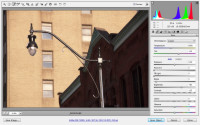
After using the eye-dropper to set a gray point, I noticed that the bricks of the background building were more as I remembered them.
Because the building in the foreground was leaning a bit to the left, I rotated the image slightly and cropped it.
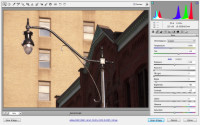 Here's what I had following the crop. Now the background building is leaning a bit, but I think that will be OK. I could use Photoshop's perspective control tools to improve this, but the keystone effect isn't so severe that I wanted to.
Here's what I had following the crop. Now the background building is leaning a bit, but I think that will be OK. I could use Photoshop's perspective control tools to improve this, but the keystone effect isn't so severe that I wanted to.
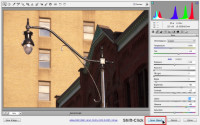 Before passing the image from Adobe Camera Raw to Photoshop, I made a few additional changes, adding a bit of clarity and brightness.
Before passing the image from Adobe Camera Raw to Photoshop, I made a few additional changes, adding a bit of clarity and brightness.
I then held the Shift key (this is important!) to open the image as a smart object.
Once the image is open in Photoshop, I can double-click the layer icon to open the image again in Camera Raw and modify it. Or, as you'll see, I can open a copy of it.
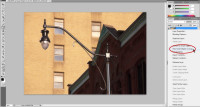 After Photoshop opened the image, the first order of business was to create two copies of the image as smart objects. This is accomplished by right-clicking the layer to reveal the context menu.
After Photoshop opened the image, the first order of business was to create two copies of the image as smart objects. This is accomplished by right-clicking the layer to reveal the context menu.
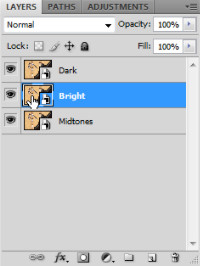 I've now named the 3 layers. This isn't essential, but it is helpful. The first layer is on the bottom. My new layers need to be above the base layer, but the order isn't important. I've named one layer Dark and the other Bright.
I've now named the 3 layers. This isn't essential, but it is helpful. The first layer is on the bottom. My new layers need to be above the base layer, but the order isn't important. I've named one layer Dark and the other Bright.
In the next steps, I will modify the images with these goals in mind:
- Dark: This is the layer that will be used to add detail to the dark areas of the image. As a result, it will appear extremely overexposed. (That is, it will be exposed for the shadows.)
- Bright: This is the layer that will be used to add detail to the light areas of the image. As a result, it will appear extremely underexposed. (That is, it will be exposed for the highlights.)
These names may seem revered to you because the image called "bright" is dark because it shows detail in the bright areas and vice versa.
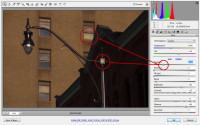 I started by working on the "bright" layer and modified the exposure for the brightest areas, the windows and the area on the lamp post with blown-out highlights.
I started by working on the "bright" layer and modified the exposure for the brightest areas, the windows and the area on the lamp post with blown-out highlights.
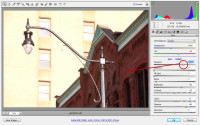 Then I returned to Photoshop and opened the "dark" layer. I needed to modify its exposure so that the red bricks would have more detail.
Then I returned to Photoshop and opened the "dark" layer. I needed to modify its exposure so that the red bricks would have more detail.
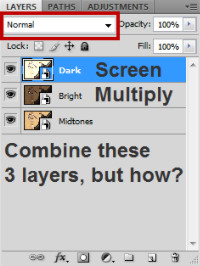 When I returned to Photoshop, I had 3 layers and I knew that I needed to combine them somehow. This is where the explanation by Michael Ninnes really began to help.
When I returned to Photoshop, I had 3 layers and I knew that I needed to combine them somehow. This is where the explanation by Michael Ninnes really began to help.
Every layer blends with the layers below it and the type of blend controls how the selected layer affects the layers below. The Screen blend mode is one that will lighten the layer below it and the Multiply blend mode is one that will darken the layers below it. But the lightening and darkening need to be applied selectively.
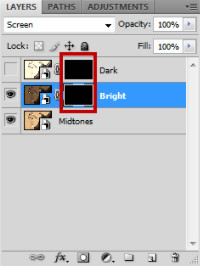 So that means I need masks. Here I have applied a black mask (which blocks everything from the layer) to both of the new layers.
So that means I need masks. Here I have applied a black mask (which blocks everything from the layer) to both of the new layers.
I have also turned off the dark layer and will work only with the bright layer.
The process involves painting with white on the mask so that the overly bright areas will be blended from the bright layer to the layer below. I worked mainly on the windows and on portions of the lamp post.
 You may think that I've overdone it a bit here. The windows are too dark. This is not what I saw when I was there. The windows were light, but had detail.
You may think that I've overdone it a bit here. The windows are too dark. This is not what I saw when I was there. The windows were light, but had detail.
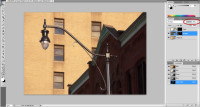 Reducing the opacity of the layer makes it partially transparent. That's more like it!
Reducing the opacity of the layer makes it partially transparent. That's more like it!
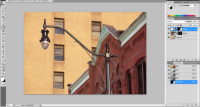 Next, I turned off the bright layer and turned on the dark layer. Now I needed to paint white on that layer's mask to reveal detail in the dark sections of the image.
Next, I turned off the bright layer and turned on the dark layer. Now I needed to paint white on that layer's mask to reveal detail in the dark sections of the image.
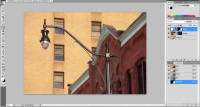 Getting the detail right around the lamp took some time and I switched between painting white to reveal the contents of the layer and painting with black to hide it.
Getting the detail right around the lamp took some time and I switched between painting white to reveal the contents of the layer and painting with black to hide it.
As with the bright layer, the effect of the dark layer was a bit too strong and I reduced the opacity.
Before and After
 Before
Before
Here's what I started with. Little or no detail in the windows; little or no detail in the red bricks.
 After
After
Although not perfect, this image is greatly improved. If you look closely at the left side of the angled roof line, you'll see that I missed a small highlight that shouldn't be there. This would be easy to fix because Photoshop's masks create changes without modifying the original image. Darkening the windows was particularly challenging where the lamp post is in front and cleaning up the area around the lamp post in front of the red bricks also took quite a bit of time.
The Importance of Learning How to Use the Tool
Photoshop is an expensive tool. Because is offers so many features and options, it's easy to be overwhelmed and confounded by the tool. Learning how to use the tool eliminates frustration. As the best craftsmen say: Time spent sharpening the tool is never wasted.
So if you have a new digital camera or a new piece of software, take some time to read the manual (if there is one); borrow a book from the library; buy a book; seek out on-line training from the manufacturer or publisher (several software publishers have improved their sites a lot in this area); or use an independent training option such as Lynda.com.
Happy New Year from Windows 7
I installed the Windows 7 release candidate back in May and the release-to-manufacturing version in September, so I've been running some version of the latest Microsoft operating system for 7 months. Seven months into my Vista experience, I'd already seen major problems. Even so, it was more than a year later when I finally removed Vista and upgraded to Windows XP. Thus far in the Windows 7 experience, I've seen virtually nothing to complain about. But that doesn't mean it's perfect.
Networking
Take networking in a secure environment, for example. I took my notebook computer to the office to see how well it would work with our Wi-Fi network. We have two: One that's open to anyone who has the appropriate passphrase and another that requires your network login and password. These credentials must be delivered to the server in an encrypted mode.
I could get to the open network easily. Windows 7 noticed it was there and asked if I wanted to join it. I said yes and provided the passphrase. Done. That's the same experience I had at home, where I run a Wi-Fi network. But when I tried to connect to the secure network, I was asked for my user name and password. When I provided them, nothing happened.
A co-worker spent about an hour looking for the solution and eventually determined that by default the Registry entry for the component that would transmit the password securely is set to disable the function. Why? And why is this not documented in a place where the average network engineer might find it? Or why isn't it included in the network setup wizard?
Ink Tools
I don't have a tablet computer so I don't turn on the Ink tools. These are what allow users to write with a stylus on a tablet computer. Windows 7 does a good job when it comes to handwriting recognition and the Ink features allow users to sketch things or to highlight points on the screen. All of these are nice features, but unwanted if you're sitting at a desktop computer and using a keyboard.
So I was surprised on Thanksgiving day when, after I had been using my Wacom digitizing tablet to work with Photoshop, I noticed that the Ink function was enabled. Whenever a dialog opened, the Ink icon appeared. The Ink writing area was parked in the upper left corner of my screen. I could tap on it to open it, but there was no way to close it. It just wouldn't go away.
Fortunately Windows 7 help is a lot better than any previous version's help. In just a few minutes, I learned that using a digitizing tablet will cause the Ink tools to appear and the "close" option to disappear from the Options menu.
But the Options menu does include an Opening tab. To close the pen input, I needed to make 2 changes there. Although it seems odd to me that just using a digitizing tablet or a tablet computer eliminates Close from the menu, this solution works and permanently changes the operation of the system.
What Did You Say?
My fancy SoundBlaster Audigy 2ZS sound card isn't certified for Windows 7. In fact, it's not supposed to work at all and I know that I'll need to replace the sound card someday. Fortunately, some clever programmers have found a way to make the sound card marginally useful until I can come up with the several hundred dollars needed to replace it.
But I can't depend on it. Sometimes the sound is good for an extended period. Other times, it plays properly for a few minutes and then garbles the sound so badly that it's unintelligible.
This is less Microsoft's fault than the fault of Creative Labs. It's the primary reason that I've decided to replace this card, when I can afford it, with a more professional unit. Although it's true that Creative Labs won't make any money providing Windows 7 drivers for older hardware, they won't make any money from the people who are so frustrated with the company that they stop buying the company's products.
The Occasional S l o w D o w n
I've seen this problem only on my desktop computer and (fortunately) not often enough to determine what causes it. On rare occasions, the system just grinds to a halt. The resource monitor shows that the CPU is virtually idle. There's little or no disk activity. No network traffic to speak of. But nothing happens when I press a key. At least not immediately.
Press the Windows key and the Start Menu might open 15 seconds later. Press Ctrl-Alt-Del to get the Task Manager and it will appear after 30 seconds or a minute. If the CPU was running at 98% busy instead of 98% idle, I'd understand. If one of the disk drives was showing 100% saturation, I'd know what was happening.
When I have time to wait, an orderly shut down is possible; I usually don't have time to wait, so I cut power to the system and everything stops. (Old computing rule: A computer's attention span is only as long as the cord that connects it to the electrical outlet.) On restart, everything is fine.
I've not seen anyone else complain about this and I haven't seen the problem on any other Windows 7 computer (including the $300 Windows 7 notebook computer my wife is using), so it may be something specific to my desktop system. Could it be related to the SoundBlaster audio card? Maybe.
For 2010, All Systems Are "Go"
When it's time to replace a computer, you'll find Windows 7 on the new machine. This is a good thing. Although I would prefer one of the more complete versions of Windows 7, (somewhat grudgingly) I will admit that Windows 7 Home Premium is adequate for most home computers. If you plan to run the computer in an office environment, though, choose Professional/Enterprise or Ultimate.
A Despicable Practice by a Company I Like and Respect
Adobe is, in my estimation, one of the best and most reliable software companies in the galaxy. It's a company that has good ideas, listens to its customers, and generally does the right thing. Nobody can be perfect all the time and this week I found that this maxim also applies to Adobe.
Thursday (17 Dec) afternoon, my wife logged off the computer and I logged on. Norton Security Scan popped up and wanted to scan the system. That would be OK except for two things: I detest the Norton suite of protective products because they use so many system resources and therefore I would never have installed Norton Security Scan.
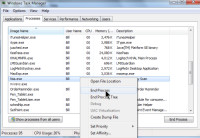 My first thought was malware, but the graphical presentation was clearly by Norton. But I didn't trust my eyes and refused to click anywhere on the application's interface. Malware writers don't play by the rules and sometimes closing an application gives it permission to do what it wants to do.
My first thought was malware, but the graphical presentation was clearly by Norton. But I didn't trust my eyes and refused to click anywhere on the application's interface. Malware writers don't play by the rules and sometimes closing an application gives it permission to do what it wants to do.
So I started the Task Manager, located the application, and killed it after checking Properties to see where it lived on the computer.
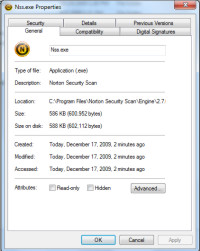 Next I uninstalled the application and deleted a leftover directory on my computer. In the process, I noticed that the two directories the application had created had a timestamp that was my logon time.
Next I uninstalled the application and deleted a leftover directory on my computer. In the process, I noticed that the two directories the application had created had a timestamp that was my logon time.
Why my logon time? My guess is that it's because my wife's account is a standard Windows 7 account, which has limited capabilities to install applications. My account, because I routinely install and remove applications, has administrator status. I suspect that a "runonce" job was set up and that it ran when I logged in. What I still don't understand is how it got around the Windows 7 user access control protections.
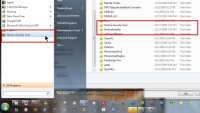
After rebooting to confirm that Norton Security Scan was gone, I started researching the situation. What installed the application. And the even more troubling question, How?
Within seconds, I found pointers to Shockwave, the former Macromedia product now owned by Adobe. The Shockwave player allows users to play some amusing games online. "Was there a Shockwave update recently?" I asked. My wife confirmed that there had been one.
That's where Norton Security Scan came from. Adobe's website confirms it.
How is Norton Security Scan from Symantec connected to Shockwave Player?
As part of a recent distribution agreement with Symantec, Adobe will offer its customers the option to install the free Norton Security Scan software as part of the Shockwave Player installation process. Only customers who accept the Norton Security Scan offer will download the Norton Security Scan software. Those who decline the offer will download and install only Shockwave Player. Norton Security Scan is only offered to users who have either already downloaded the Google Toolbar or who are not eligible to receive the Google Toolbar offer.
What is Norton Security Scan?
Norton Security Scan is a powerful and easy-to-use tool to help computer users evaluate threats that may reside on their PC's. Norton Security Scan informs users if their PC's have been infected with viruses, spyware or malware. With an easy to use interface, users can either run a full scan of their system or run a QuickScan, which is a fast scan of the areas of their computer that are most likely to be targeted by security threats. Norton Security Scan automatically detects and receives regular updates, so it can effectively identify the latest virus and spyware threats. Adobe Shockwave users who install Norton Security Scan can upgrade to Norton Internet Security or Norton 360 at a special discount.
Why is Norton Security Scan being distributed with Shockwave Player?
Symantec and Adobe are interested in providing our customers with the best possible user experiences. Norton Security Scan is being offered as part of the Shockwave Player install process as an option to give Adobe Shockwave users the confidence that potential PC threats can be identified through on-demand or weekly security assessments so they can take the necessary steps to remediate these risks and ensure proactive security. Users who do not wish to take advantage of this offer can easily opt out of the installation.
Does Norton Security Scan contain spyware?
Norton Security Scan does not contain spyware, nor is it a spyware application. Adobe is committed to protecting customers' privacy and does not distribute software that is considered spyware.
Is it possible to uninstall Norton Security Scan once it has been installed?
Yes, you can uninstall it using Microsoft® Windows® Add or Remove Programs.
Source: http://www.adobe.com/products/director/special/crossproduct/faq.html
The key parts of the explanation are these:
- "Adobe Shockwave users who install Norton Security Scan can upgrade to Norton Internet Security or Norton 360 at a special discount." Adobe's real reason for offering the application (applications such as these are typically called "craplets" in the business) is probably monetary: Adobe almost certainly receives a payment for everyone who upgrades to the full version of the Norton product.
- "Users who do not wish to take advantage of this offer can easily opt out of the installation." To avoid having the craplet installed, the user must specifically opt out of the process. This is totally unethical and I'm both shocked and dismayed to see Adobe adopt this practice.
If Adobe wants to offer its users a free trial of a product, that's fine. But be honest enough about it to make a legitimate offer: "If you would like to install a free trial of Norton Security Scan, click here." In other words, make the offer opt-in.
- To express your opinion to Adobe, click here.
- To express your opinion to Symantec, the owner of the Norton brand, click here.
ADOBE'S RESPONSE
As with most large companies, Adobe doesn't provide direct access to corporate personnel. Instead, they work with public relations firms. Adobe's PR firm is one of the largest and best known agencies in the business, Edelman. I presume that Adobe works with Edelman's Silicon Valley office in in San Mateo. Adobe's corporate headquarters buildings are located in San Jose, but the Creative Suite team that I usually work with is in Seattle. Shockwave was developed by Macromedia, a company that Adobe acquired a few years ago. Macromedia's headquarters building was in San Francisco, so the Shockwave team is probably still in California.
When I told my Edelman contact about this story, he said that he would try to have a response from the Shockwave team by the end of business on Friday (18 December 09).
EOB on the West Coast is 8pm where I live. Unfortunately, there was no response by then. This could be because the Macromedia team considers the problem trivial and didn't reply. But it could also be because the Macromedia team considered the problem is serious and needed to kick it upstairs to Adobe's corporate communications staff.
I want to give you Adobe's response and I will as soon as I have it. For now, all I can report is that "no response was received from Adobe prior to the publication deadline."
This report will be posted to the website 18 December 09 at 20:13:09 in preparation for Saturday morning's e-mail update; I will update this report when I have a response from Adobe.
Short Circuits
Does "It's About Time" Ring True?
The FTC says that chip maker Intel has engaged in anti-competitive practices. Intel, of course, disagrees. But computer makers say that Intel's "discount" structure is designed to punish those who buy too many CPUs from competitors such as Advanced Micro Devices (AMD). "Too many" might be as little as 1.
Intel is the largest maker of CPUs in the world, but the FTC says it got that way illegally. The European Union has said similar things. The FTC now has some additional legislative backing that may help it give competitors a chance in the marketplace.
The agency accuses Intel of conducting a systematic campaign to block rivals from selling their microchips by cutting off access to the market. Intel says it was simply offering discounts to computer builders who bought a lot of product from Intel. The builders have a different story, though, and describe practices that paid builders to withhold AMD-based systems from the market.
The FTC has been investigating Intel's business procedures for a year now and the latest charges follow by days a $1.25 billion settlement with rival AMD.
Intel's chief counsel predictably called the latest FTC action "misguided and unwarranted".
The latest FTC complaint is an administrative action. That means it will be adjuticated by an administrative law judge within the FTC, but not until late in 2010.
So stay tuned.
Google. Phone? Maybe.
Google says it won't be manufacturing its own phone. Rumor mongers disagree. Google is already a thorn in the side of the industry but few people see that as a bad thing because cellular service providers rank a few points below used car sales people and legislators. And understandably so.
Google could shake up the smart-phone industry if it wanted to.
According to the rumor mongers, Google will begin selling phones as early as January. The phones will not be locked in to any particular carrier (Take that, Apple!) and consumers will be able to select any network that is compatible with the phone.
This could mean lower prices for consumers and eliminating the need to sign up for a 2-year (or longer) contract that has serious penalties for early termination. But the Google phone will probably cost more because it won't be subsidised by a carrier.
Catching Up with Europe
In Europe, phones are unlocked by default.
Will Americans and Canadians be willing to pay $400 to $600 for a smart phone instead of $100 and locking themselves into a 2-year contract? Maybe it depends on how much you value "freedom".
Google has been mum (as usual) on its plans.
Data points:
- Nearly all (90%) phones sold in the US and Canada are purchased from cell phone companies.
- Nokia has attempted to sell unlocked phones without subsidies from the carriers. They have failed.
This will be a big change for Google, a company that bases its existence on software, not hardware. The Nexus One is hardware. Whether Google can succeed in the hardware market is anyone's guess.


 The author's image: It's that photo over at the right. This explains why TechByter Worldwide was never on television, doesn't it?
The author's image: It's that photo over at the right. This explains why TechByter Worldwide was never on television, doesn't it?
